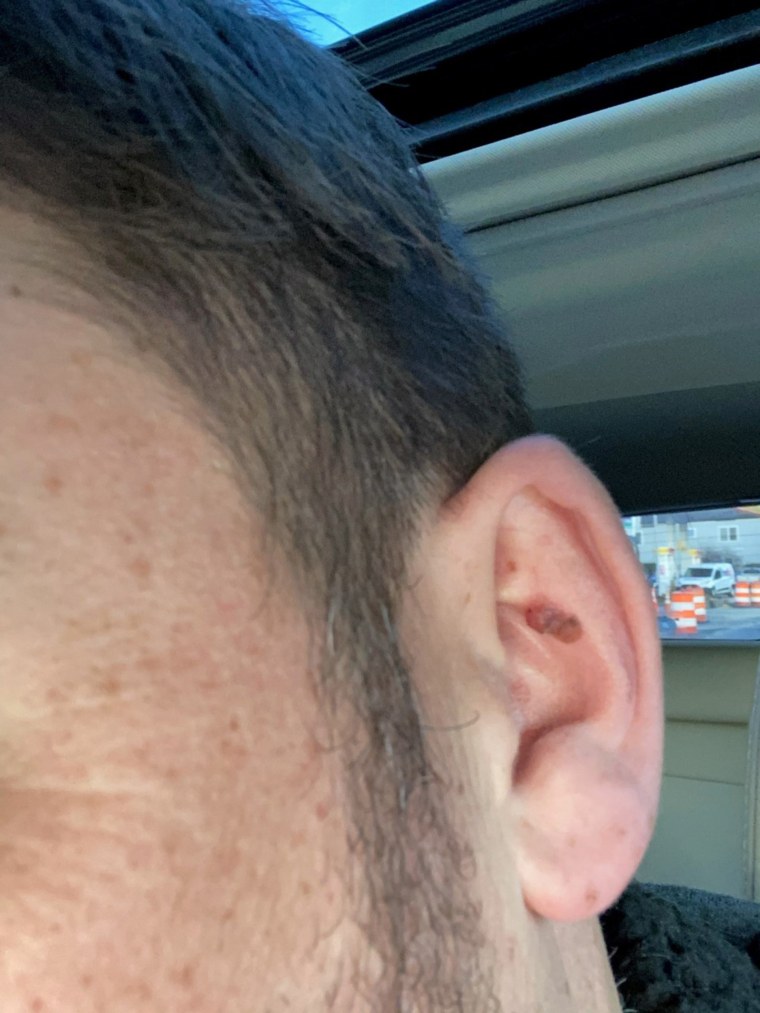Of all the places melanoma can lurk on the body, Alexander Gupman’s skin cancer showed up on his ear.
He’d been watching the spot for years — a mole-like growth on the cartilage near his left ear canal — but it didn’t seem to change so doctors weren’t concerned.
Then in the fall of 2020, the first year he’d skipped his annual skin check because of the coronavirus crisis, a 7-year-old friend of his daughter looked at him and said, “‘Your ear looks funny, Alex.'”
“I didn't take it seriously in November. It took a second person in December to say, ‘You really need to get that looked at,’” Gupman, 47, told TODAY.
“What I've learned is that if someone says something looks funny on your skin, you really should get it checked out... people need to take it seriously.”

Taking another look at the spot on his ear, he did notice it had grown larger and at one point started to bleed. He sent a photo of it to his dermatologist in January and was immediately scheduled for a biopsy. The diagnosis: stage 3 melanoma.
To get rid of the deadliest form of skin cancer, doctors removed the spot along with part of his ear and a couple of lymph nodes that had been infected.
For a month, Gupman walked around with “a dime-sized hole in my ear” before it was rebuilt using skin from his left leg. He called the results “absolutely amazing.” But a nerve was nicked during the surgery so he doesn't have feeling in the left side of his face.
Gupman, a government employee and a single father of three who lives in Silver Spring, Maryland, now receives immunotherapy. He has to undergo scans every three months and will receive frequent skin checks for the rest of his life because there’s a high chance of reoccurrence, he said.

About 25% of all melanomas occur in the head and neck, said Dr. Brian Gastman, surgical director of the Melanoma & High-Risk Skin Cancer Program at the Cleveland Clinic in Ohio. He called melanoma of the ear “extremely common,” recalling a recent case where he removed about two-thirds of the patient's ear.
“It is sneaky. The ear itself is a very wavy structure… sometimes (melanomas there) are found because of pain or bleeding,” said Gastman, who is not treating Gupman but commented in general.
“The problem with the ear is probably of all the sites in the body, no more site than maybe the ear is connected through so many channels we call lymphatics to lymph nodes.”
Like many people, Gupman protected his face with sunscreen but didn’t think about applying it to his ears. He loves being outdoors and recalled kayaking down the Mississippi River in college, with full sun exposure for 45 days.
“I for some reason just never thought of the ear as something you needed to protect. I never got sunburned on my ears,” he said.
Unprotected exposure to the sun’s ultraviolet rays is the most significant risk factor for skin cancer, yet more than a third of Americans, 35%, incorrectly believe — or are unsure — that as long as you don’t burn, tanning is safe, according to the American Academy of Dermatology.
Gupman had been “extremely religious” about getting annual skin checks and he’s had 10-15 suspicious moles removed from his body, but the biopsy results always came back as nothing to worry about. Taking a year off from his dermatologist visit was an acceptable risk, Gupman thought, and that's when he developed melanoma.

To prevent skin cancer, the American Academy of Dermatology urged people to:
- Apply a broad-spectrum, water-resistant sunscreen with an SPF of 30 or higher to all skin not covered by clothing and reapply it every two hours or after swimming or sweating.
- Seek shade. The sun’s rays are strongest between 10 a.m. and 2 p.m.
- Wear sun-protective clothing, such as a lightweight, long-sleeved shirt, pants, a wide-brimmed hat and sunglasses with UV protection, when possible.
Everyone should also understand their own risk profile, Gastman said. Risk factors include having multiple sunburns in childhood, having 50 or more moles, being fair-skinned with blue eyes and having a family history of melanoma. A person who checks all the boxes is at an extremely high risk of melanoma and probably needs to see a dermatologist twice a year, he noted.
Others may just need to do self-exams and bring any changes — based on the ABCDEs of melanoma — to their doctor’s attention. The “E,” which stands for evolving, is the most important part, he noted. That means a mole that’s changing color, becoming more irregular or asymmetric, growing, itching, bleeding, crusting, ulcerating or painful.
“Ultimately, it's not the patients’ job to biopsy themselves. It's the patients’ job to see something and say something,” Gastman said.
“With some of my patients, I call it whack a mole. They’ve had melanoma and I say, look you may get a mole and it may be high risk of turning into melanoma, but we'll just keep cutting them out. When you're 100 years old, you'll tell your great-grandchildren about all the scars you have on your body, but you'll never die of your disease.”



